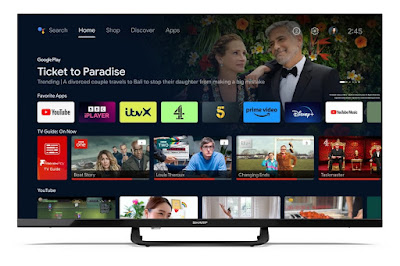Well, my television broke again, losing power to the screen for the second time in four years, in the same way it happened last time. With the memory of the previous two-week wait for it to be fixed rising to the surface, I threw up my hands and bought a replacement. Provided this one lasts for a few more years, I have realised this may be the last regular television I will buy.
My first personal TV was a fourteen-inch cathode ray tube TV bought for £139 in 1996, weighed seven kilograms (15.4 lbs), had two one-watt speakers, no subtitles or teletext ability, and used approximately 150 watts an hour, CRT screens holding high voltages even after turn-off. The back of it was riven with ventilation holes, because they were surely needed.
My new TV, a Sharp 32FH8KA, weighs half as much, has a thirty-two-inch LED screen like my previous Toshiba model, but this time with high dynamic range so effective that the backlight can be turned down to save power. Along with two twelve-watt speakers that have some bass, the unit is only a few inches thick – the circuit board and connectors stick out from the back of the TV, and is the only part that remains ventilated, because the screen hardly produces any heat, and because so little energy is lost through heat, it only uses twenty-six watts an hour. It is also fully Android compatible, making it pretty much a computer, into which other computers can be connected. With inflation, £139 in 1996 is now £271 – this new TV cost only £199.
Aside from the minimum expectations of a TV’s ability having greatly expanded over time, connectivity has also greatly changed. I only ever connected a VHS video recorder to the old portable TV in the 1990s, via the single SCART connector, but I now have an Apple TV box – “Android” is something that other people do – a Blu-ray player, a separate DVD player that accepts region 1 DVDs from North America, and an Atari Flashback console, all connected at once, covering all possibilities.
While I am happy with the speakers on my new TV, a sound bar is usually the first add-on others would buy nowadays, especially if streaming services like Netflix, Amazon Prime and the BBC iPlayer are accessible through the TV itself – apart from the Sky Glass TV, made for subscribers to that service, TVs with built-in soundbars have not appeared, as if better sound is expected to be something that needs to be added to a TV. I could easily have bought a large computer monitor with enough connectors for what I require, but these doesn’t really exist either.
The ability to just buy an all-purpose screen may arrive if no unified decision is made on the future of broadcasting. It is not clear if “5G Broadcast”, using the mobile phone network to deliver TV signals, is the ultimate choice if more of the current TV signals are repurposed for mobile use, while satellite TV, my main source for “regular” broadcasts on my new TV, may only remain if Sky commits to continuing with it beyond the end of the 2020s – if not, why should SES build more Astra satellites? If then, my TV will become that all-purpose screen, but I should never fear, for the box and manual states it supports the H.265 video codec, should any UK broadcaster decide to start using it – that’s good, I suppose.



No comments:
Post a Comment